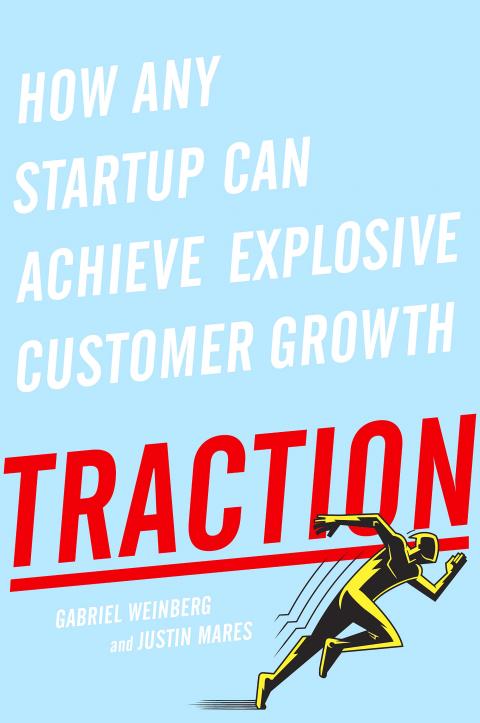This isn’t really my kind of book. In essence it’s a self-help business manual devoted to ways of attracting customers to new products. The reason I decided to get my hands on a copy was that its publicity proclaimed that the work had begun life as a self-published e-book, and then had gone on to sell 35,000 copies by using the techniques described inside it.
This immediately caught my eye because I was at the time about to self-publish an e-book myself, a novel that’s finally appeared this week. Here was the answer to the problem of how to find readers, I thought. Unfortunately I was disappointed. There isn’t a specific reference to selling books anywhere in the volume.
In the business world, “traction” means gaining sales. And there’s no doubt that this book, written in a catchy style and covering sales tactics, most of them online, will appeal to people whose working lives take them into this field. Writers are different, however, at least self-styled aesthetes such as myself.

Book reviews are undoubtedly useful sales tools for the publishers concerned, but this has no connection with my motives in writing them. I’m concerned to put great reads in the way of possible readers, and also to conduct the exercise of critical evaluation in as dispassionate a fashion as possible. What publishers do with my reviews afterwards is of almost no interest to me.
I think this is the attitude of artists who are far more creative than I am. The poet Shelley once tried to publicize something he’d written by standing on a box in Dublin and popping leaflets into the hats of passers-by. But he didn’t keep it up for long, quickly reverting to his true calling, writing poems. Being a salesman went against the grain, and posterity has to be immensely grateful to him for that.
I once happened to mention in an e-mail to a middle-level executive of one of the world’s biggest publishing houses that I thought advertising essentially involved telling lies to make money. She was so outraged that she never contacted me again. Maybe I exaggerated, but I nonetheless continue to think that sales generally is something I have little desire to get involved with.
The reason for this is that selling something to someone can so easily involve attempting to manipulate them. There are plenty of examples of this in this book. One chapter, for example, deals with questions the salesman might ask a prospective customer. What are your business problems? In what ways to they impinge on your business success? These are called “problem questions” and “implication questions,” and on the surface they sound sympathetic. But they are in reality simply leading up to the crucial “need-payoff questions,” in which the potential customer is asked whether what he really needs isn’t the product the salesman is intent on selling.
This procedure is very different from the questions a priest or a teacher might ask, both of them ideally wanting to help the individual concerned in an objective, dispassionate way. I don’t claim any personal virtue in this matter, but am simply saying that artists, teachers and even priests are, by and large, the kinds of people I like best. My attitude to salesmen isn’t hostile, simply cautious. Everyone has to make a living, and it could well be that they had little choice in the matter, and are in reality among the nicest people in the world. But this doesn’t stop me being suspicious of the methods in which they may have been trained.
Traction lists 19 ways a new product can be marketed. These include every kind of online interaction imaginable, from “affiliate programs” to “search engine marketing,” but also extending to off-line tools such as trade shows, conferences and speaking engagements. On the way you’re introduced to a huge number of Internet Web sites, such as (taken almost at random) Yelp, HubSpot, Weebly, OkCupid, Unbounce, Moz, WordPress … around 100 such are cited, often with extracts from interviews with their founders on the methods they found most effective in building their companies.
There’s a special language to selling, too, featuring words like black-hat tactics (ones that violate search engine guidelines), fathead or long-tail searches (ones that search for popular or relatively abstruse terms), spreadsheets, sales funnels, closing a sale and so on.
I once found myself speculating on the origin of the word “business.” It’s remarkable for its lack of specifics, and I wondered if when it first came into use in the modern sense (in the early 18th century, when banking and commerce first became major activities), it wasn’t a euphemism for something people didn’t feel happy talking about. Up to then most activities had either a religious aspect or were related to pleasing a patron, but here suddenly were people concerned — what a scandal! — simply with making money for themselves. Better not be too specific, then, so let’s just call it “business.”
Not surprisingly, after reading Traction things everywhere looked different. When I went into a supermarket, for instance, I immediately recognized the ways in which products were being sold — by advertising, by promoting certain items by placing them in prominent positions and by suggesting that certain prices were for a short time only. These are essentially what this book is talking about, only in their online manifestations.
Be that as it may, my strategy with regard to my new novel has so far just been making a list of friends and other contacts and sending them details, one at a time, after the day of publication. Other than that, I’ve created a page for it on Facebook called Themysteryreligionsofgladovia. But whoops! Doesn’t this already smack of the dreaded business of sales promotion? Maybe I’m not as unsullied as I think.

Following the shock complete failure of all the recall votes against Chinese Nationalist Party (KMT) lawmakers on July 26, pan-blue supporters and the Chinese Communist Party (CCP) were giddy with victory. A notable exception was KMT Chairman Eric Chu (朱立倫), who knew better. At a press conference on July 29, he bowed deeply in gratitude to the voters and said the recalls were “not about which party won or lost, but were a great victory for the Taiwanese voters.” The entire recall process was a disaster for both the KMT and the Democratic Progressive Party (DPP). The only bright spot for

Water management is one of the most powerful forces shaping modern Taiwan’s landscapes and politics. Many of Taiwan’s township and county boundaries are defined by watersheds. The current course of the mighty Jhuoshuei River (濁水溪) was largely established by Japanese embankment building during the 1918-1923 period. Taoyuan is dotted with ponds constructed by settlers from China during the Qing period. Countless local civic actions have been driven by opposition to water projects. Last week something like 2,600mm of rain fell on southern Taiwan in seven days, peaking at over 2,800mm in Duona (多納) in Kaohsiung’s Maolin District (茂林), according to

Aug. 11 to Aug. 17 Those who never heard of architect Hsiu Tse-lan (修澤蘭) must have seen her work — on the reverse of the NT$100 bill is the Yangmingshan Zhongshan Hall (陽明山中山樓). Then-president Chiang Kai-shek (蔣介石) reportedly hand-picked her for the job and gave her just 13 months to complete it in time for the centennial of Republic of China founder Sun Yat-sen’s birth on Nov. 12, 1966. Another landmark project is Garden City (花園新城) in New Taipei City’s Sindian District (新店) — Taiwan’s first mountainside planned community, which Hsiu initiated in 1968. She was involved in every stage, from selecting

As last month dawned, the Democratic Progressive Party (DPP) was in a good position. The recall campaigns had strong momentum, polling showed many Chinese Nationalist Party (KMT) lawmakers at risk of recall and even the KMT was bracing for losing seats while facing a tsunami of voter fraud investigations. Polling pointed to some of the recalls being a lock for victory. Though in most districts the majority was against recalling their lawmaker, among voters “definitely” planning to vote, there were double-digit margins in favor of recall in at least five districts, with three districts near or above 20 percent in